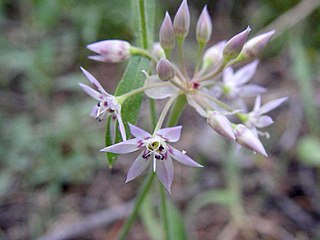
Allium campanulatum is a species of wild onion known by the common name dusky onion or Sierra onion. This is a flowering plant native to the western United States from southeastern Washington and northern Oregon to southern California, and western Nevada. The dusky onion grows in foothills and mountains, especially in dry areas, such as chaparral habitats.

Castilleja rubicundula is a species of Indian paintbrush known by the common name cream sacs. It is native to northern California and southwestern Oregon. It is found in coastal and inland grasslands.

Ceanothus cuneatus is a species of flowering shrub known by the common names buckbrush and wedgeleaf ceanothus.
Hieracium greenei is a species of hawkweed known by the common name Greene's hawkweed.

Potentilla muirii, commonly known as granite mousetail, is a species of flowering plant in the rose family. It is endemic to the High Sierra Nevada of California, where it grows on rocky slopes and cliffs.

Lepidium nitidum, known by the common name shining pepperweed, is a species of flowering plant in the mustard family.

Arctostaphylos purissima is a species of manzanita known by the common name La Purisima manzanita.
Astragalus pachypus is a species of milkvetch known by the common name thickpod milkvetch. It is endemic to California, where it is known from many types of open habitat across the southern half of the state. This is a robust perennial herb forming stands of tough, wiry stems up to 80 centimeters tall. Leaves are up to about 16 centimeters long and are made up of many narrow leaflets. The plant flowers in inflorescences of 4 to 28 cream-colored flowers. The fruit is a sharp-beaked legume pod up to about 3 centimeters long which dries to a leathery, mostly hairless texture. There are two varieties of this species. The rarer, Jaeger's bush milkvetch, is known mostly from western Riverside County.
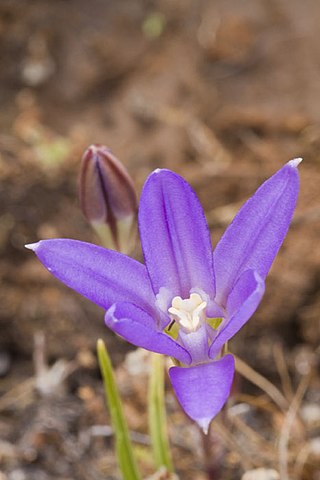
Brodiaea jolonensis, known by the common name chaparral brodiaea, is a species of flowering plant in the cluster-lily family.

Cirsium andrewsii is an uncommon species of thistle known by the common name Franciscan thistle. It is endemic to California, where it is known from the coastline of the San Francisco Bay Area from Marin to San Mateo Counties. There are also reports of isolated populations in the Klamath Mountains and in the Sierra Nevada.
Erodium brachycarpum is a species of flowering plant in the geranium family known by the common names hairy-pitted stork's-bill and shortfruit stork's bill. It is native to southern Europe but it is known elsewhere as an introduced species and often a weed, such as the west coast of the United States where it is widespread in California and Oregon.
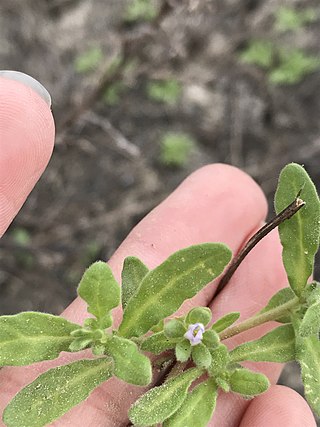
Nama stenocarpa is a species of flowering plant in the borage family known by the common name mud fiddleleaf. It is native to northern Mexico and areas of southern California, Arizona, and Texas, where it is known from wet habitat such as marshes and swampy valley wetlands.
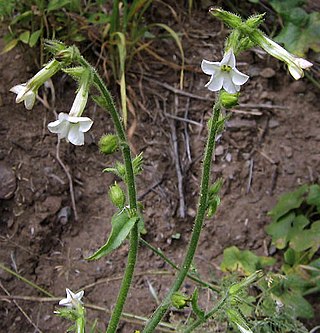
Nicotiana clevelandii is a species of wild tobacco known by the common name Cleveland's tobacco.
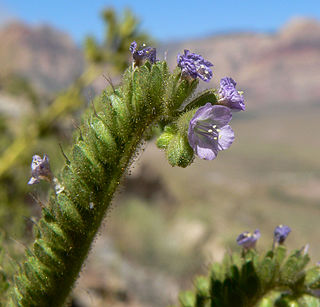
Phacelia anelsonii is a species of phacelia known by the common name Aven Nelson's phacelia. It is native to the Southwestern United States, where it is known from scattered occurrences in southwestern Utah, southern Nevada, and eastern California. It can be found in scrub and woodland habitat. It is named after the botanist Aven Nelson.

Phacelia argentea is a rare species of phacelia known by the common names sand dune phacelia and silvery phacelia. It is native to the coastline of southwestern Oregon and far northwestern California, where it was counted at a total of 33 sites in 1995. It is the only phacelia species endemic to coastal sand dune habitat, an ecosystem which is altered and declining in the area.
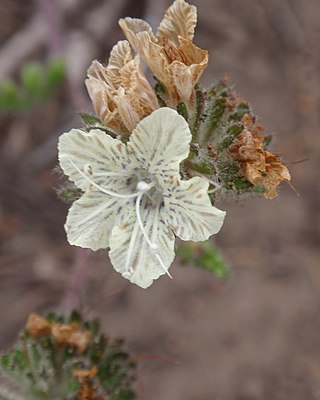
Phacelia malvifolia, with the common name stinging phacelia, is a species of phacelia. It is native to California, where it grows along the northern and central Coast and the California Coast Ranges. its distribution extends north along the coast just into southwestern Oregon. It grows in forest and scrub habitat.

Phacelia neglecta is a species of flowering plant in the borage family, Boraginaceae. Its common names include alkali phacelia and neglected scorpionweed. It is native to the deserts of the southwestern United States in Nevada, Arizona, and southeastern California, where it grows in varied desert habitat, including areas with alkali soils. It is likely that its distribution extends into Baja California.

Phacelia pachyphylla is a species of phacelia known by the common name blacktack phacelia. It is native to the deserts of California and Baja California, where it grows in sandy alkali flats and scrub.
Phacelia parishii is an uncommon species of phacelia known by the common name Parish's phacelia. It is native to the desert southwest of the United States, where it is known from scattered occurrences in Nevada and Arizona, and about two occurrences in California. It grows in desert scrub and alkali soils such as in playas, barren dry lakes, and gypsum beds.
Phacelia phacelioides, the Mt. Diablo phacelia, is a species of phacelia. It is endemic to California, where it is known from about 20 occurrences in the coastal mountain ranges of the inner San Francisco Bay Area, including Mount Diablo. It is a resident of chaparral and woodland habitat.
















